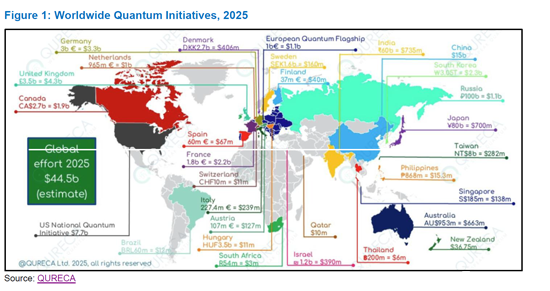|
市场调查报告书
商品编码
1720934
印度的量子通讯的发展:International Quantum Communication Conclave 2025的考察:政府、学术界和产业界携手合作,利用量子金钥分发 (QKD)、光量子通讯 (PQC) 和光子晶片等本土技术,为印度的量子未来铺路India's Quantum Communication Journey - Insights from the International Quantum Communication Conclave 2025: Government, Academia, and Industry Unite to Drive India's Quantum Future with Indigenous Innovations in QKD, PQC, and Photonic Chips |
|||||||
本报告概述了2025年国际量子通讯高峰会上宣布的战略举措、创新和里程碑,并展示了它们如何推动印度面向未来的量子网路建设。
视觉

印度正快速崛起,成为全球量子安全通讯竞赛中的关键参与者。 2025年举行的国际量子通讯会议(IQCC)凸显了印度在该领域日益增强的技术实力。量子通讯(QC)有望成为未来安全网路的核心技术。与传统密码学不同,量子通讯利用量子力学定律,对传统和量子网路威胁均具有很强的抵御能力。全球量子技术投资已超过445亿美元,印度正透过自主研发技术和全国性应用,积极推动策略转型,确立其在量子技术领域的领导地位。
印度政府已将量子通讯列为其国家量子计画(NQM)的核心支柱之一,并致力于建立一个强大的生态系统,以支持其研究、商业化和应用。印度理工学院马德拉斯分校(IIT Madras)、电信发展中心(C-DOT)和拉曼研究所(RRI)等机构正在领导这些基础计画。例如,IIT Madras已在钦奈建立了城域量子存取网路(MAQAN)光纤测试平台。 C-DOT 还在新德里的 Sanchar Bhavan 进行了量子金钥分发 (QKD) 即时实验,标誌着一项重要的里程碑。此外,印度理工学院德里分校 (IIT Delhi) 和国防研究与发展组织 (DRDO) 已在实验室环境中成功展示了 50 公里光纤链路上的纠缠 QKD,并在现场试验中演示了 8 公里光纤上的纠缠 QKD。他们还在北方邦的 Prayagraj 和 Vindhyachal(100 公里)之间进行了城际 QKD 通讯试验。基于这些努力, "本地连接量子互联网" (QUILA) 计画旨在透过将地面和卫星 QKD 与后量子密码 (PQC) 和量子记忆体相结合,建造一个全国性的量子互联网,透过 2000 公里的量子骨干网路连接各大城市。
CDOT 作为印度量子商业化的引擎,正在开发基于 COW(相干单向)和 DPS(差分相移)协议的认证 QKD 系统。 CDOT 也正在开发独立于仪表的量子金钥分发 (MDI-QKD) 原型,以防止侧通道攻击。 CDOT 的多路復用和多芯光纤 QKD 创新技术还能实现超过 120 公里的安全通讯距离,而无需使用昂贵的暗光纤。 重要的是,CDOT 已实现单光子探测器等关键组件的国产化,从而将成本降低了 90%,并显着减少了对海外来源的依赖。
调查对象
被言及了的组织
|
|
目录
摘要
简介
- 量子通讯重要性的理由
IQCC 2025主要的焦点
- 国家当务之急:印度国家量子博物馆 (NQM)、印度国家量子技术中心 (CDOT) 和印度理工学院马德拉斯分校 (IIT Madras) 的作用
- 基础项目:MAQAN 和 QUILA
- CDOT 的独特创新
- 小型化与规模化:迈向晶片级量子金钥分发 (QKD)
- 卫星量子通讯:印度国家科学研究院 (RRI) 和印度太空研究组织 (ISRO) 领先
- QNu 实验室:从研发到部署
- 量子安全密码学:已准备好集成
- 全球合作与学习:东芝、IBM、爱立信
所谓印度的量子生态系统重要的理由?
总论:量子通讯的印度的决定性飞跃
This brief outlines the strategic initiatives, innovations, and milestones showcased at the International Quantum Communication Conclave 2025 that are steering India's progress toward future-ready quantum networks.
VISUALS

India is fast emerging as a significant player in the global race toward secure, quantum-based communications. The International Quantum Communication Conclave (IQCC) 2025 spotlighted India's growing capabilities in this field, with quantum communications (QC) poised to become the backbone of future secure networks. Unlike traditional encryption, quantum communication leverages the laws of quantum mechanics, offering resilience against classical and quantum cyber threats. As global investments in quantum technologies exceed $44.5 billion, India is strategically positioning itself to lead with indigenous innovations and national-scale deployments.
The Indian government has made quantum communications a core pillar of its National Quantum Mission (NQM), aiming to create a robust ecosystem of research, commercialization, and deployment. Several institutions such as Indian Institute of Technology (IIT) Madras, the Centre for Development of Telematics (CDOT), and the Raman Research Institute (RRI) are spearheading foundational projects. For example, IIT Madras has pioneered the Metro Area Quantum Access Network (MAQAN) metro fiber testbed in Chennai, while C-DOT's live Quantum Key Distribution (QKD) setup at Sanchar Bhawan, New Delhi marks an important milestone. Separately, IIT Delhi and the Defence Research and Development Organisation (DRDO) have jointly demonstrated entanglement-based QKD over 50 km of fiber link in lab conditions and 8 km of optical fiber in field trials, in addition to executing a 100 km inter-city QKD trial between Prayagraj and Vindhyachal in Uttar Pradesh. Building on these, the ambitious Quantum Internet with Local Access (QUILA) program aims to link major Indian cities through a 2,000 km quantum backbone, integrating terrestrial and satellite QKD with Post-Quantum Cryptography (PQC) and quantum memory, laying the foundation for a national quantum internet.
CDOT, emerging as the country's quantum commercialization engine, has developed certified QKD systems based on Coherent One Way (COW) and Differential Phase Shift (DPS) protocols. CDOT also is prototyping Measurement Device Independent (MDI) QKD for mitigating side-channel attacks. Its innovations in multiplexed and multi-core fiber QKD remove the need for costly dark fiber while extending secure communication ranges to 120+ km. Critically, CDOT has indigenized key components like single-photon detectors, cutting costs by 90% and reducing foreign dependency.
Another major leap forward is the shift toward chip-scale QKD. Miniaturizing bulky quantum components into photonic integrated circuits will allow for scalable, cost-effective deployment across telecom and cloud networks. India is investing heavily in this direction via the Ministry of Electronics and IT (MeitY) and the Department of Science and Technology (DST), funding photonic chip R&D at institutions like Indian Institute of Science (IISc) and IITs. These chips will also form the building blocks for future 6G and AI infrastructure.
Satellite quantum communication is the next frontier. RRI, in collaboration with the Indian Space Research Organization (ISRO), is developing ground-to-satellite QKD systems with adaptive optics and precision tracking, offering a viable solution for long-distance, terrain-agnostic secure links. Their research in device-independent randomness and free-space optics enhances India's readiness for global-scale quantum communication networks.
Finally, industry players like QNu Labs are transitioning research into deployable systems by commercializing hybrid models that integrate QKD, PQC, and quantum random number generators. These efforts, aligned with NQM, mark India's emergence as a serious contender in the global quantum race - strategically, scientifically, and commercially.
Research Coverage
Organizations mentioned:
|
|
Table of Contents
Summary
Introduction
- Why does quantum communications matter?
IQCC 2025 key highlights
- National imperatives: the role of NQM, CDOT, and IIT Madras
- Foundational projects: MAQAN and QUILA
- Indigenous innovation by CDOT
- Miniaturization and scale: Toward chip-scale QKD
- Satellite-Based Quantum Communication: RRI and ISRO lead the charge
- QNu Labs: from R&D to deployment
- Post-Quantum Cryptography: Ready for Integration
- Global alignment and learnings: Toshiba, IBM, and Ericsson
Why India's quantum ecosystem matters?
Conclusion: India's defining leap in quantum communications
List of Figures
- Figure 1: Worldwide Quantum Initiatives, 2025
- Figure 2: Quantum Networks Deployment Projects across India










